Toyota Grand Highlander (AS10) 2024 Owners Manual / Interior features / Using the other interior features / Other interior features
Toyota Grand Highlander (AS10): Other interior features
USB charging ports
The USB charging ports are used to supply 3 A of electricity at 5 V to external devices.
The USB charging ports are for charging only. They are not designed for data transfer or other purposes.
Depending on the external device, it may not charge properly.
Refer to the manual included with the device before using a USB charging port.
■ Using the USB charging ports
On the instrument panel (center)
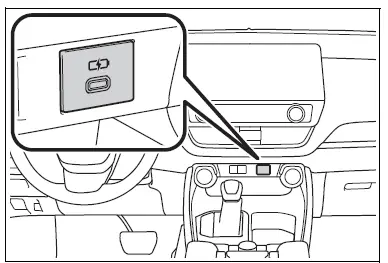
On the instrument panel (passenger side)
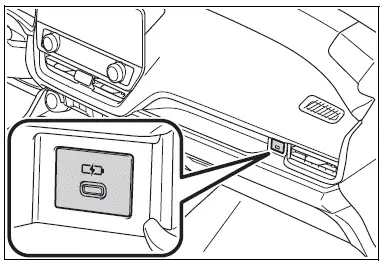
Rear of console box
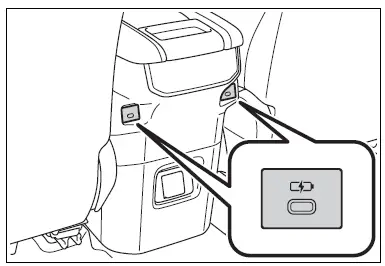
Third seats
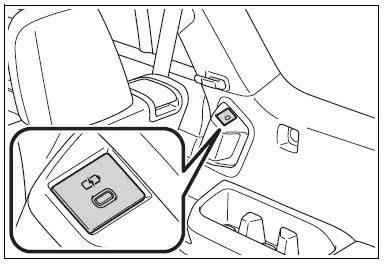
■The USB charging ports can be used when
The engine switch is in ACC or ON.
■Situations in which the USB charging ports may not operate correctly
- If a device which consumes more than 3 A at 5 V is connected
- If a device designed to communicate with a personal computer, such as a USB memory device, is connected
- If the connected external device is turned off (depending on device)
- If the temperature inside the vehicle is high, such as after the vehicle has been parked in the sun
■About connected external devices
Depending on the connected external device, charging may occasionally be suspended and then start again. This is not a malfunction.
NOTICE
■To prevent damage to the USB charging ports
- Do not insert foreign objects into the ports.
- Do not spill water or other liquids into the ports.
- Do not apply excessive force to or impact the USB charging ports.
- Do not disassemble or modify the USB charging ports.
■To prevent damage to external devices
- Do not leave external devices in the vehicle. The temperature inside the vehicle may become high, resulting in damage to an external device.
- Do not push down on or apply unnecessary force to an external device or the cable of an external device while it is connected.
■To prevent battery discharge
Do not use the USB charging ports for a long period of time with the engine stopped.
Wireless charger
A portable device, such as a smartphone or mobile battery, can be charged by just placing it on the charging area, provided the device is compatible with the Qi wireless charging standard created by the Wireless Power Consortium.
The wireless charger cannot be used with a portable device that is larger than the charging tray.
Additionally, depending on the portable device, the wireless charger may not operate properly.
Refer to the operation manual of the portable device.
■ The "Qi" symbol
The "Qi" symbol is a trademark of the Wireless Power Consortium.
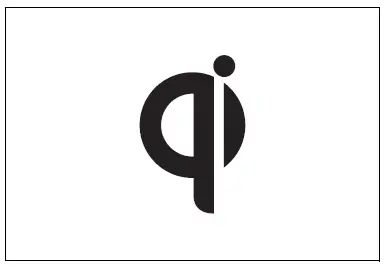
■ Name for all parts
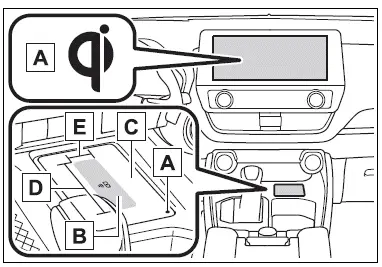
- Operation indicator light
- Charge area*
- Charging tray
- Approximately 3.9 in. (10 cm)
- Approximately 1.0 in. (2.5 cm)
*: The charging coil in the wireless charger can be moved within the charge area up to the position of the charging coil inside a portable device. Charging is possible if the center of the coil of the portable device is placed within the charge area.
Additionally, if 2 or more portable devices are placed on the charging tray at the same time, each charging coil may not be detected correctly and charging may not be possible.
■ Using the wireless charger
Place the portable device on the wireless charger.
Place the charging side of the portable device down with the center of the device in the center of the charge area.
When charging, the operation indicator light (orange) on the wireless charger comes on.
Refer to "Situations in which the function may not operate normally" when charging is not performed.
When charging is complete, the operation indicator light (green) on the wireless charger comes on.
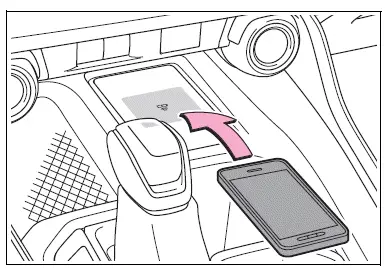
■ Recharging function
- If a certain amount of time has elapsed since charging completed and the portable device has not been moved, the wireless charger will restart charging.
- If a portable device is moved significantly within the charging area, the charging coil may disconnect and charging may temporarily be stopped. However, if a charging coil is detected within the charging area, the charging coil inside the wireless charger will move near the other coil and charging will resume.
■ Rapid charging function
- The following portable devices support rapid charging.
- Portable devices compliant with WPC Ver1.3.2 and compatible with rapid charging
- iPhone's with an iOS version that supports 7.5 W charging (iPhone 8 and later models)
- Portable devices compatible with Galaxy original rapid charging standard.
- When a portable device that supports rapid charging is charged, charging automatically switches to the rapid charging function.
■ Operation indicator light status
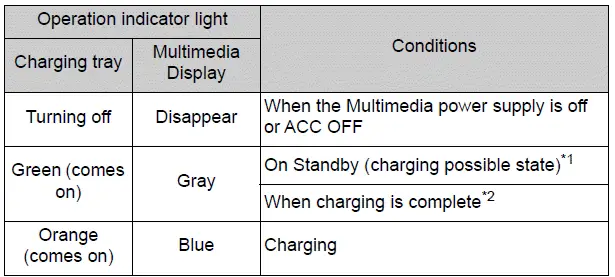
*1:Charging power will not be output during standby. A metallic object will not be heated, if it is placed on the wireless charger in this state.
*2:Depending on the portable device, there are cases where the operation indicator light will continue being lit up orange even after the charging is complete.
■ The wireless charger is not working properly.
The followings are situations in which the wireless charger does not work properly and how to deal with the possible causes.
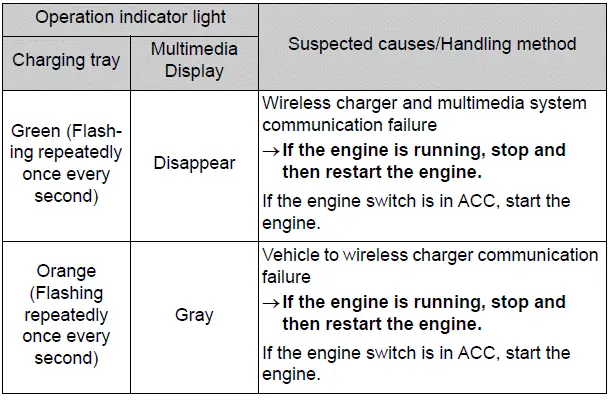
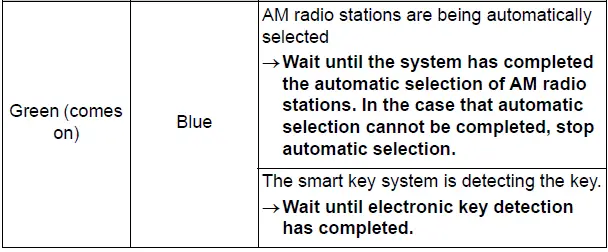
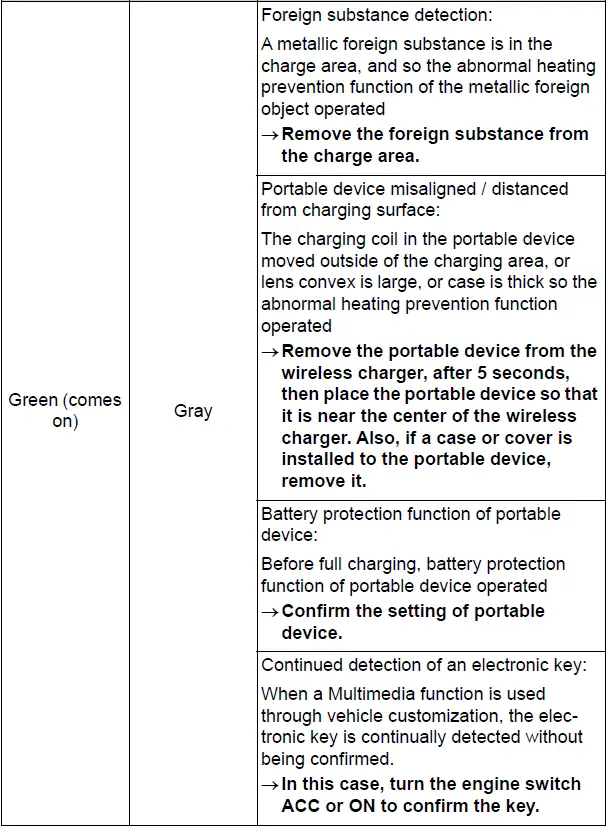

■The wireless charger can be operated when
The engine switch is in ACC or ON.
■Portable devices that can be charged
- Portable devices compatible with the Qi wireless charging standard can be charged by the wireless charger. However, compatibility with portable devices that comply with Qi Ver. 1.0, 1.3.2 and later versions is not guaranteed.
- The wireless charger is designed to supply low power electricity (5 W or less) to a cellular phone, smartphone, or other portable device.
However, portable devices, such as the following, can be charged with more than 5 W.
- 7.5 W charging compatible iPhones can be charged at 7.5 W or less.
- Devices that comply with independent Galaxy charging standards support rapid charging. Check the specifications of each portable device for the charging electricity.
- Portable devices compliant with EPP output as defined by WPC standard Ver1.3.2. can be charged at 15 W or less.
■Using the smart key system
During charging, when the smart key system searches for an electronic key, charging may be temporarily suspended.
■If a cover or accessory is attached to the portable device
Do not charge a portable device if a cover or accessory which is not Qi compatible is attached. Depending on the type of cover (including the certain genuine manufacture parts) and/or accessory attached, it may not be possible to charge the portable device. If the portable device is placed on the charging area and does not charge, remove the cover and/or accessories.
■AM radio cooperation function during charging
- During charging, if noise occurs when listening to the AM radio, the charging frequency is automatically changed to reduce the noise.
- When automatically seeking AM radio stations, charging will be suspended to prevent charging noise from being detected as a radio station. Charging will resume automatically when seek tuning is stopped.
■Charging precautions
While charging, the wireless charger and the portable device will become warm. This is not a malfunction. If a portable device becomes warm while charging and charging stops due to the protection function of the portable device, wait until the portable device cools down and charge it again.
Also, to decrease the temperature inside the wireless charger, a fan may operate. This does not indicate a malfunction.
■Sound generated during operation
Operation sounds may be heard when the engine switch is pressed to change to ACC or ON, or when a portable device is being detected.
This does not indicate a malfunction.
■Situations in which the wireless charger may not operate correctly
In the following situations, the wireless charger may not operate correctly:
- When a portable device is fully charged
- When a portable device is being charged by a wired connection
- When there is a foreign object between the charging area and portable device
- When the temperature of a portable device becomes high while charging
- When the temperature near the charging tray is 95ºF (35ºC) or more due to being in direct sunlight, etc.
- When a portable device is placed with its charging surface facing up
- The small portable device such as foldable type is placed in an area misaligned from the charge area
- When a portable device is larger than the charging tray
- When the vehicle is near a TV tower, electric power plant, fuel station, radio station, large display, airport, or other facility that generates strong radio waves or electrical noise
- The electronic key is not inside the vehicle
- When the any of the following
objects are between the charging
surface of a portable device and
the charging are:
- Thick cases or covers
- A case or cover attached with an uneven or tilted surface, so that the charging side is not flat
- Thick decorations
- Accessories, such as finger rings, straps, etc.
- When there is a gap between the charging side of the portable device and the charge area due to a protrusion such as a camera on the charging side of the portable device.
- When the portable device is in
contact with, or is covered by any
of the following metallic objects:
- Cards covered with metal, such as aluminum foil
- Metallic wallets or bags
- Coins
- Heat packs
- Recorded media such as CDs and DVDs
- Metallic decorations
- Metallic cases or covers
- Casing which has magnet in it on the charging side of the portable device
- When wireless keys (that emit radio waves) other than those of your vehicle are being used nearby
- When 2 or more portable devices are placed on the charging tray at the same time
- If a portable device built in S-pen (Galaxy "Note" series etc.) used, a portable device that inserted S-pen is placed on the tray
In situations other than above, if the wireless charger does not operate properly or the operation indicator light blinks continuously, the wireless charger may be malfunctioning.
Contact your Toyota dealer.
■If the smartphone OS has been updated
If the smartphone OS has been updated to a newer version, its charging specifications may have changed significantly. For details, check the information on the manufacturer's website.
■Trademark information
iPhone is a trademark of Apple Inc., registered in the U.S. and other countries.
WARNING
■Caution while driving
When charging a portable device while driving, for safety reasons, the driver should not operate the portable device.
■Precautions for when driving
Do not charge small, lightweight portable devices, such as wireless earbuds, while driving. Lightweight devices may fly off of the charging tray, possibly leading to an accident.
■Caution regarding interference with electronic devices
People with implantable cardiac pacemakers, cardiac resynchronization therapy pacemakers or implantable cardioverter defibrillators, as well as any other electrical medical device, should consult their physician about the usage of the wireless charger.
Operations of the wireless charger may have an affect on medical devices.
■To prevent damage or burns
Observe the following precautions.
Failure to do so may result in the possibility of fire, equipment failure or damage, or burns due to heat.
- Do not put any metallic objects between the charging area and the portable device while charging.
- Do not attach metallic objects, such as aluminum stickers, to the charging area.
- Do not charge portable devices with aluminum stickers or other metallic objects attached to the side which touches the charging area.
- Do not store items on the wireless charger instead of in an auxiliary box.
- Do not apply force or impact to the wireless charger.
- Do not disassemble, modify or remove the wireless charger.
- Do not attempt to charge portable devices which are not compatible with the Qi wireless charging standard.
- Do not allow magnetic objects to come near the wireless charger.
- Do not perform charging if the charging area is dirty.
- When not using the wireless charger, to prevent foreign matter or liquids from contacting it, make sure to close the lid.
- Keep the lid open while charging is taking place.
- Do not cover the wireless charger with a cloth or other object while charging.
NOTICE
■To prevent failure or damage to data
- Do not place magnetic cards, such as a credit card, or magnetic recording media, close to the wireless charger while charging. Otherwise, data may be erased due to the influence of magnetism. Additionally, do not bring precision instruments such as wrist watches, close to the wireless charger, as such objects may malfunction.
- Do not perform charging with a
contactless smart card, such as
a transportation system IC card,
between the charging surface of
a portable device and the
charging area. The IC chip in
the card may become extremely
hot, possibly damaging the portable
device or smart card.
Be extra careful to not charge a portable device with a case or cover which a contactless smart card can be inserted.
- Do not leave portable devices in the cabin. The temperature inside the cabin may become high when parked in the sun, and cause damage to the device.
■To prevent battery discharge
Do not use the wireless charger for a long period of time with the engine stopped.
Armrest
Second seats (8-seat models)
Pull the armrest down for use.
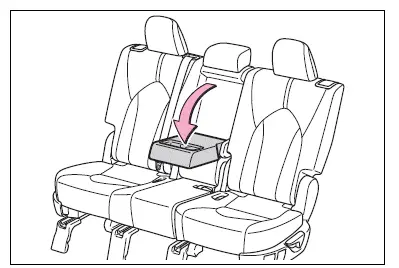
Second seats (7-seat models)
Pull the armrest down for use.
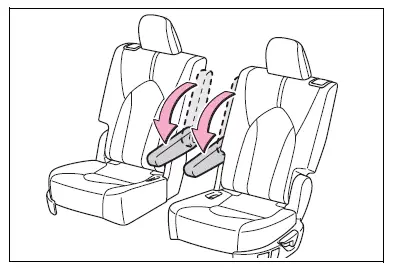
NOTICE
■To prevent damage to the armrest
Do not apply too much load on the armrest.
Assist grips
An assist grip installed on the ceiling can be used to support your body while sitting on the seat.
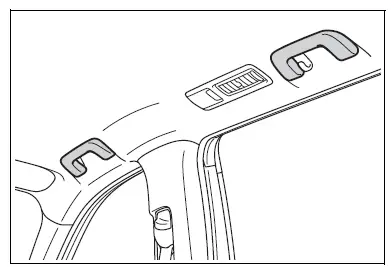
WARNING
■Assist grip
Do not use the assist grip when getting in or out of the vehicle or rising from your seat.
NOTICE
■To prevent damage to the assist grip
Do not hang any heavy object or put a heavy load on the assist grip.
Coat hooks
The coat hooks are provided with the rear assist grips.
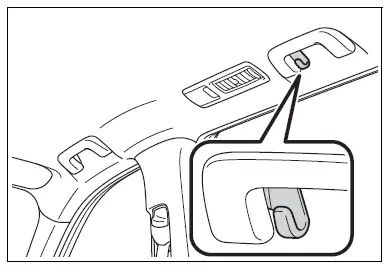
WARNING
■Items that must not be hung on the hook
Do not hang coat hangers or other hard or sharp objects on the hook. If the SRS curtain shield airbags deploy, these items may become projectiles, causing death or serious injury.
Power outlets (12 VDC)
Please use as a power supply for electronic goods that use less than 12 VDC/10 A (power consumption of 120 W).
When using electronic goods, make sure that the power consumption of all the connected power outlets is less than 120 W.
Inside the console box
Open the lid.
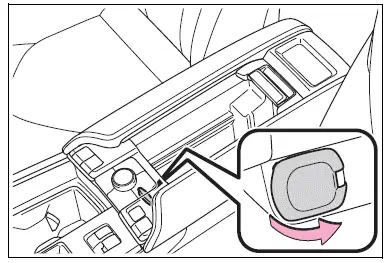
Rear of console box (if equipped)
Open the lid.
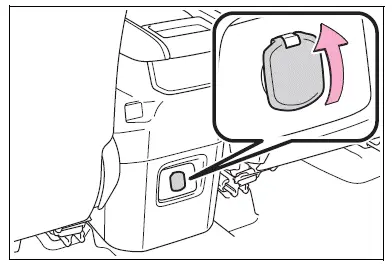
■The power outlet can be used when
The engine switch is in ACC or ON.
■Using the power outlet
When the engine restarts after having been stopped by the Stop & Start system, the power outlets may be temporarily unusable, but this is not a malfunction.
■When turning the engine switch off
Disconnect electrical devices with charging functions, such as mobile battery packs.
If such devices are left connected, the engine switch may not be turned off normally.
NOTICE
■To avoid damaging the power outlet
Close the power outlet lid when the power outlet is not in use.
Foreign objects or liquids that enter the power outlet may cause a short circuit.
■To prevent the battery from being discharged
Do not use the power outlet longer than necessary when the engine is not running.
Power outlets (120 VAC) (if equipped)
Accessories that use less than 100 W.
Open the lid.
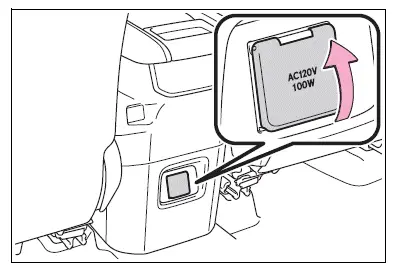
■The power outlet can be used when
The engine switch is in ON.
■Using the power outlet
When the engine restarts after having been stopped by the Stop & Start system, the power outlets may be temporarily unusable, but this is not a malfunction.
■When turning the engine switch off
Disconnect electrical devices with charging functions, such as mobile battery packs.
If such devices are left connected, the engine switch may not be turned off normally.
NOTICE
■To prevent the fuse from being blown
Do not use a 120 VAC appliance that requires more than 100 W. If a 120 VAC appliance that consumes more than 100 W is used, the protection circuit will cut the power supply.
■To avoid damaging the power outlet
Close the power outlet lid when the power outlet is not in use.
Foreign objects or liquids that enter the power outlet may cause a short circuit.
■To prevent the battery from being discharged
Do not use the power outlet longer than necessary when the engine is not running.
■Appliances that may not operate properly
The following 120 VAC appliances may not operate properly even if their power consumption is under 100 W.
- Appliances with high initial peak wattage
- Measuring devices that process precise data
- Other appliances that require an extremely stable power supply
Sun visors
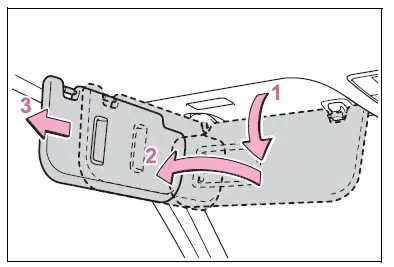
- To set the visor in the forward position, flip it down.
- To set the visor in the side position, flip down, unhook, and swing it to the side.
- To use the side extender, place the visor in the side position, then slide it backward.
Vanity mirrors
Slide the cover to open.
The light turns on when the cover is opened.
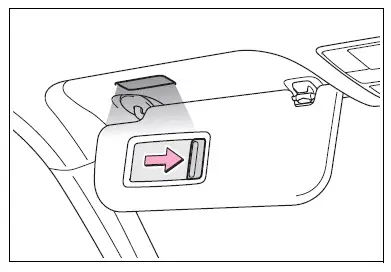
■To prevent battery discharge
If the vanity lights remain on when the engine switch is turned off, the lights will go off automatically after 20 minutes.
NOTICE
■To prevent the battery from being discharged
Do not leave the vanity lights on for extended periods while the engine is off.
Rear door sunshades
1. Pull the tab up.
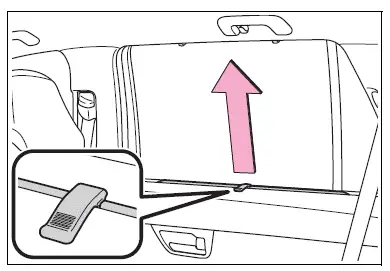
2. Hook the sunshade on to the anchors.
To lower the sunshade, pull the tab up slightly to unhook the shade from the anchors, and lower it slowly.
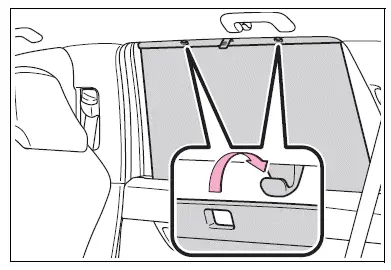
WARNING
■Closing the rear door sunshade
When a rear door sunshade is in use, do not put fingers, etc. on the anchors or in the groove of the rear door sunshade. Otherwise, a finger, etc. may get caught, possibly causing an injury.
NOTICE
■To ensure normal operation of the sunshades
- Do not put anything in an area where it may interfere with the operation of a rear door sunshade.
- To prevent damage to the rear door sunshades, do not apply excessive load or attach items to the rear door sunshades.
Similar pages:
Cargo and luggage
Take notice of the following
information about storage
precautions, cargo capacity
and load.
Capacity and distribution
Cargo capacity depends on the
total weight of the occupants.
(Cargo capacity) = (Total load
capacity) - (Total weight of
occupants)
Steps for Determining Correct
Load Limit -
(1) L ...
Headlight switch
The headlights can be operated
manually or automatically.
Operating instructions
Operating the switch
turns on the lights as follows:
U.S.A.
Canada
The headlights, daytime
running lights and
all the lights listed below turn
on and off automatically.
(When the engine switch is in
ON.)
...


